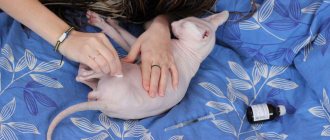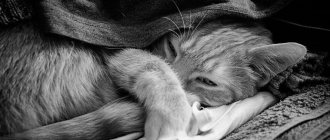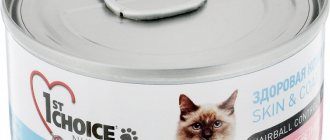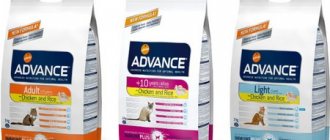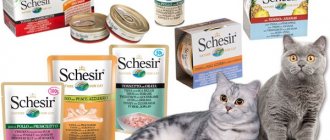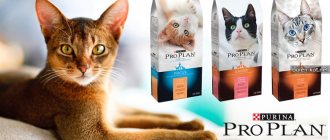Why do cats need taurine?
Taurine is an amino acid that helps cells produce proteins necessary for the proper functioning of the cat's body. Participates in the formation of bile to digest fats in the small intestine, reduce cholesterol and blood pressure. The benefit of the amino acid lies in its assistance in metabolic processes, storage and transportation of nutrients. The element is needed to control blood sugar levels, maintain the health of the urinary system, and visual organs.
Cats, unlike humans and dogs, do not produce taurine. The amino acid must be supplied to them with food.
In cats, the need for taurine is 400 mg per 1 kg of body weight.
If you do not receive enough of this acid, your health begins to deteriorate over time. Deficiency develops between 5 months and 2 years. The process is long and symptoms do not appear externally.
Diagnosis of food allergies in cats
Before prescribing treatment, the veterinarian must conduct a general clinical examination of the pet. Important criteria that the doctor pays attention to are medical history (what the pet has taken or is taking in food), the condition of the skin, fur and visible mucous membranes.
Suspicion of a food allergy should be confirmed using laboratory tests, including:
- general blood analysis;
- blood chemistry;
- blood test to determine the titer of specific immunoglobulins E.
Based on the research results, the doctor draws up an individual treatment regimen, the basis of which should be an elimination diet that gradually eliminates potential allergens from the diet.
An important role in making an accurate diagnosis is played by differential diagnosis from atopic dermatitis, flea dermatitis, psychogenic alopecia and ailments caused by ecto- and endoparasites.
Symptoms of Taurine Deficiency
There are no direct symptoms of taurine deficiency. All signs are associated with developing diseases, primarily dilated cardiomyopathy and retinal degeneration. Therefore, differential diagnosis with these diseases is carried out.
If a plasma analysis shows a taurine content of less than 25 nmol/ml, then they speak of taurine deficiency. In healthy cats, this figure is 50 nmol/ml or higher. However, the result is influenced by how much amino acid was supplied with food before the study or by prolonged fasting. Therefore, it is difficult to judge from the result how much substance the animal lacks. More accurate data is shown by whole blood analysis. A cat is healthy if the taurine level in whole blood is 250 nmol/ml or higher. If it is lower, a deficiency is diagnosed.
What does an overdose lead to?
An excess of taurine in cats is rare. More often in kittens. Leads to muscle weakness and the development of chest pathology - funnel chest.
Vitamin deficiency
If this vitamin is absent from the cat’s body for a long time, a number of negative factors may arise. First of all, vision problems appear. The animal begins to see much worse and is poorly oriented in space. Digestive problems may be noticed. After each meal, as a rule, the gag reflex is actively manifested. Obvious signs are diarrhea or constipation. The most dangerous symptom is heart failure, accompanied by general weakness, drowsiness and malaise.
If such ailments are observed, then you should immediately introduce vitamins with taurine for cats into the diet. A lack of it can lead to the development of serious diseases. In some cases it is a harbinger of death.
Where is taurine found?
Most taurine is found in meat, liver, heart, and kidneys. Found in small quantities in dairy products and eggs. Plant products practically do not contain this substance. The highest concentrations are in raw meat and fish. During heat treatment, the taurine contained in them is destroyed. The leaders in amino acid levels are turkey meat and tuna fish.
| Product | Amino acid level (mg/100g) | % of daily norm |
| Dark meat turkey | 360 | 77 |
| Tuna (raw fish) | 280 | 71 |
| Chicken (dark meat) | 170 | 43 |
| Raw red fish | 130 | 33 |
| Chicken heart and liver | 117 | 30 |
Taurine in industrially produced cat food is guaranteed to be in the “premium” and “super premium” classes. In industrial economy class feeds, the additive is minimal or absent.
If the animal eats vegetarian food or the composition contains cereals in the first place, then the cat does not receive acid in the required volume. She needs supplements.
The study determined the minimum level of taurine in cat food:
- For dry granules - 1 -1.2 g per 1 kg of feed (0.1-0.12%).
- For canned food - no less than 1.7 g, and better - 2-2.5 g per 1 kg (0.2-0.25%).
It has been scientifically proven that even a dose of 10 g of taurine per kilogram of feed is safe for animals.
Features of application
Taurine for cats can be found in two main forms: drops and tablets.
The first option is intended for the treatment of retinal diseases. One drop should be instilled 2-3 times a day. Naturally, the animal will resist, so it is recommended to firmly fix its body. The general course of treatment lasts three months. If during this time the problem cannot be eliminated, then you can repeat the procedures after a two-week break.
The dosage in tablets is determined by a specialist, depending on the degree of deficiency of this vitamin in the body. It is almost impossible to force a cat to eat medicine. It is recommended to add it to food or dilute it with a small amount of water.
Best Taurine Supplements
Taurine is available in the form of powder, tablets, solutions, and dragees. The doctor will tell you which feed additive to choose for your pet, focusing on the animal’s health, age, and physiological characteristics.
The following feed additives are considered good:
- Beaphar's Top 10 is a multivitamin supplement containing essential vitamins, minerals and amino acids. It has a shrimp flavor and is well eaten by cats. This is a big plus, since giving a pill to a cat is not easy and is a real stress for the pet. Weakness, lethargy, bad mood - indications for using Top 10.
- Omega NEO - a multivitamin delicacy contains mussels, seaweed, squid liver - components rich in Omega-3 essential fatty acids, taurine, biotin and vitamins. The smell and taste of the treat is attractive to cats. The palatability is excellent.
- Canina Taurin – available in powder form for mixing into food. Suitable for any type of food. The Kanina company produces a vitamin gel, which can also be added to canned food or taken from a syringe.
- Ceva is an inexpensive multivitamin tablet with taurine and biotin. There are supplements for adults and kittens. They are used both as a feed additive and as a treat to reward cats.
- GimPet - the company produces vitamins in fancy shapes: mice, hearts, pads, etc. A variety of Schnurries - heart-shaped vitamins for cats. According to reviews from cat breeders, multi-colored hearts have become favorites for many cats. Pets also love Topinis “mice” with cottage cheese, milk, salmon, chicken - they all contain taurine.
- Doctor Zoo is a line of various food additives. Vitamins “Health and Beauty” and “Health of Skin and Coat” are produced with taurine. Suitable for any method of nutrition.
Deficient amino acid and why it is needed
The most unpleasant thing is that symptoms can take years to appear. But when they are already pronounced, the disease may be in a very advanced form.
Signs:
- moving around the apartment, he comes across all the obstacles;
- unable to calculate distance when jumping;
- overly timid;
- apathetic;
- suffers from lack of appetite;
- labored breathing;
- bad coat and teeth;
- frequent infections;
- digestive disorders;
- miscarriages and congenital deformities in offspring.
Deficiency is often the fate of starving animals, as well as those whom “kind” owners treat with dog food or improperly prepared natural products.
Clinical symptoms of taurine deficiency develop slowly. Depending on the cat's age, they can progress anywhere from five months to two years before becoming obvious.
With a lack of taurine, the retina of the eye will gradually degenerate, thereby worsening the cat’s vision. This condition is called retinal atrophy. Taurine deficiency also leads to weakening of the heart muscle, causing dilated cardiomyopathy. Taurine is part of bile salts, so its deficiency can cause digestive upset.
If diagnosed early, dilated cardiomyopathy can be reversible with nutritional supplements. If left untreated, retinal atrophy will eventually lead to complete blindness, while dilated cardiomyopathy will progress to heart failure and death.
During pregnancy, the cat should receive more taurine to maintain her health and ensure normal growth and development of the kittens. Low taurine levels result in weak and premature kittens. Growing kittens with taurine deficiency may have delayed growth and development.
They do not appear immediately, but usually after months and even years, depending on the age of the animal.
The following signs will tell you about the onset of pathological changes in the retina (atrophy):
- the cat bumps into obstacles (corners);
- cannot calculate distance when jumping;
- became overly fearful.
Loss of appetite, apathy and difficulty breathing will indicate that the heart muscle suffers due to the lack of taurine. Untreated dilated cardiomyopathy leads to heart failure and often death of the cat.
We invite you to familiarize yourself with: Lifestyle of a river otter. Where does the otter live: features of the habitat
Poor coat and teeth, digestive disorders, low resistance to infections are also indicators of the lack of taurine in the body.
Amino acid deficiency also affects the reproductive system, interfering with fertilization (ovulation is often impossible) or preventing the normal course of pregnancy (miscarriages, congenital deformities). If offspring are nevertheless born, the kittens grow poorly and have hidden pathologies.
Sulfur amino acid deficiency is most often observed in cats that are starving or those that eat dog food and improperly prepared natural foods.
Nutritional supplements have come to the rescue of worried cat owners. They have been proven to slow down/stop retinal atrophy, and also cope with dilated cardiomyopathy (especially at its onset), and generally improve the cat's well-being and appearance.
Taurine Supplements
They are safe and very rarely cause side effects, such as allergies or stomach upset. Excess taurine that the body does not absorb is removed from it in the urine. So, vitamins with taurine:
- Beaphar Kitty's Taurine Biotin (cheese flavor). The package contains 180 vitamins, each of which, along with taurine, contains a set of essential microelements;
- Gimpet – recommended for cats of all breeds. The amino acid is also supplemented with a complex of daily microelements;
- Omega Neo - here taurine and other amino acids are isolated from squid liver. Daily dose – 3-6 tablets, taken year-round;
- Petvital Vitamin-Gel is a vitamin gel with taurine and other active ingredients that prevent stone deposition. The gel is also prescribed to neutralize the negative effects of low-quality industrial feed;
- Doctor ZOO for cats Biotin Taurine - accelerates metabolism, maintaining the balance of taurine, biotin and trace elements.
Secrets of Taurine
Veterinarians at the University of California have experimentally determined which foods contain the most taurine (more on that later) and how to preserve it during cooking.
The researchers concluded that cooking errors directly affect the concentration of a sulfur-containing amino acid, which can quickly dissolve in water.
Some advice from American veterinarians:
- try not to freeze meat/fish, as the amino acid is easily washed out when defrosted;
- do not chop the pulp too finely and do not put pressure on it: this contributes to the destruction of taurine and other useful elements;
- the most noticeable loss of taurine occurs during cooking in water, where it is simply washed out;
- if you boiled meat, use broth so that the animal receives the amino acid that migrated there.
The largest amount of amino acid is required for the muscle tissue of the heart and retina, therefore, if there is a deficiency of the substance in the pet’s body, these organs are the first to suffer.
The breeder should be alert to the following symptoms in the cat:
- drowsiness and lethargy;
- hypothermia (decrease in body temperature below the standard value);
- excessive hair loss;
- destruction of tooth enamel;
- blurred vision;
- dehydration;
- loss of appetite.
Baldness and hair loss are one of the signs of taurine deficiency.
If the problem is not recognized at the initial stage, the consequences can be serious:
- decreased reproductive activity, miscarriages during pregnancy;
- loss of vision;
- various congenital pathologies in kittens.
Having figured out why a cat needs Taurine, it is quite simple to identify a deficiency of this substance in the animal’s body. Common symptoms include blurred vision, physical weakness, drowsiness and lethargy, hair loss, destruction of tooth enamel, and loss of appetite.
After experienced laboratory technicians have determined the amino acid level, a qualified specialist will immediately explain which taurine-containing preparations should be introduced into the cat’s diet. Modern solutions that are often used in veterinary practice include the use of special dietary supplements. The main thing that breeders need to remember is that Taurine is not harmful to cats in numerous studies. However, a deficiency of this amino acid can cause diseases, even leading to death.
It is important to note that damage to the heart muscle or retina, which can be caused by a lack of taurine, can manifest itself in completely different ways in each individual individual. For example, in some individuals there are no clinical symptoms at all.
Taurine is essential for the development and maintenance of nerve tissue integrity.
Therefore, in order for a veterinarian to make an accurate diagnosis, it is necessary to conduct tests and find out what the level of taurine in the animal’s blood is. If its level is insufficient, the diagnosis is confirmed.
Because research has confirmed the critical role of taurine in a number of serious heart diseases, the optimal level of taurine in a cat's body has been revised upward. According to scientists, the recommended minimum taurine content should be 1000 milligrams of taurine per kilogram of dry matter. This norm is determined for dry food and is 0.1%. For canned food, this norm is twice as high and amounts to 0.2%.
Cats only get taurine from the food they eat.
It is very important to note that no taurine is added to dog food, which is another reason why cats should not be fed dog food. In any case, you cannot feed your cat this food for a long time. For the same reason, manufacturers of super premium food, in order to prevent taurine deficiency, as well as to eliminate the consequences caused by a lack of this amino acid, add taurine to their products much more than the required minimum. For example, Royal Canin foods such as RCFI and FELISTAR contain 0.15% taurine for adult cats and 0.25% for kittens.
If you find an error, please highlight a piece of text and press Ctrl Enter.
What cat foods contain
All professional cat food includes taurine, so there is no need to worry about enriching your pet’s body with the amino acid.
The most popular brands are:
- Friskies Adult;
- Kitekat;
- Night Hunter;
- Sheba "Pleasure";
- Optimal;
- Royal Canin and others
When choosing ready-made food, it should be taken into account that 1000 mg of dry composition should contain 0.1% taurine; in canned food, the norm is doubled.
All professional cat foods include taurine
Some breeders prefer to feed cats natural food.
With this approach, it is important not only to develop a balanced menu, but also to pay great attention to the quality of the products used, as well as their storage conditions.
When left in the refrigerator or cooked for a long time, the lion's share of the active substance evaporates, and the remaining part may not cover the body's needs for taurine. Therefore, it is logical to supplement food with vitamin complexes, including amino acids.
Among the recommended ones:
- Doctor ZOO;
- Gimpet;
- CEVA;
- Beaphar.
To replenish amino acids in the animal’s body, you need to add the following products to the menu:
- turkey;
- tuna;
- chicken meat;
- beef heart;
- a rabbit;
- liver;
- seafood.
To compensate for the lack of taurine, you can add turkey to your cat’s menu.
Treatment
If a cat is allergic to food, treatment should only be prescribed by a veterinarian. A specialist must diagnose this particular immunopathological process. Depending on the age, condition, and individual characteristics of the pet, a treatment regimen is selected. Treatment will be comprehensive. There may be several trips to the clinic. The doctor must monitor the progress of treatment and the effect of prescribed medications.
Cat owners should not treat themselves. In addition, many antihistamines intended for humans are not suitable for animals. It is allowed to use creams and ointments that relieve itching and irritation on the skin.
The doctor will help identify the allergen and answer the question “is the cat allergic to food, how to treat it?” Prescribe medications. Will inform you about the doses and duration of taking medications. Treating an allergic reaction is not easy. It can take from several weeks to several months. The time for therapy depends on the symptoms and condition of the cat.
If the allergy is advanced and the pet’s condition is severe, he is prescribed medications containing hormones. They have a number of side effects, but they will quickly help alleviate the pet’s condition and start the process of eliminating all signs.
Antihistamines are prescribed along with hormones. These include Clemastine, Tavegil, Pipolzin, Diphenhydramine and others. They have contraindications.
Medicines containing biotin (vitamin B7) may also be prescribed. B7 promotes collagen production. The use of preparations with this vitamin will have a beneficial effect on your pet’s skin. Scratched wounds and eczema will begin to heal faster.
If your pet has worms, this will worsen the allergy. In addition, due to parasites, the effectiveness of treatment will decrease. Therefore, the owner must worm the pet.
During treatment, the cat is switched to another food. The owner must ensure that the diet does not contain foreign or low-quality food. The veterinarian will ask you to monitor your pet while eating. The owner must record everything that happens to the cat and share observations with the doctor.
Allergy prevention
To prevent the disease from appearing in a cat, you need to pay attention to preventive measures. They are simple.
- The animal must eat high-quality, balanced food.
- It is necessary to give him vaccinations on time. This will increase the body's resistance.
- Take care of, play, pet your pet. If a cat feels unwanted, its immune system weakens.
- A clear nutrition schedule. It is necessary to feed your pet on time and in sufficient quantity.
- It is important to carry out anthelmintic procedures on time.
Owners are required to prevent diseases, including allergies, in pets. If you notice symptoms, consult a doctor immediately. Only a competent specialist will help furry animals recover. The doctor will not only relieve the symptoms, but also make sure that cats will never develop allergies to food again.
